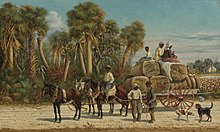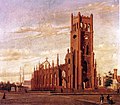William Aiken Walker
William Aiken Walker (born March 11, 1839 in Charleston , South Carolina , † January 3, 1921 there ) was an American genre and portrait painter . He was best known for portraits and genre scenes from the life of black plantation workers in the southern states .
Life
Walker, son of a Protestant cotton merchant from Charleston from an Irish family, enjoyed a good education in the social and value system of Antebellum South . He started painting at a young age. He grew up in his native city of Charleston until his father's death in 1842, when he and his mother moved to live with relatives in Baltimore . In 1848 they returned to Charleston, where he exhibited his first painting at the South Carolina Institute Fair in 1850 at the age of twelve . Around 1860 he is said to have undertaken a trip to Europe, which also took him to Düsseldorf , at the time a popular place to study for American painters, where he may have visited various studios and thus got to know the work of the Düsseldorf School of Painting .
At the beginning of the Civil War that broke out between the Confederate States of America and the northern states of the United States in the spring of 1861 , he had already returned to his home country. He volunteered with the Confederate States Army and initially served in the Second Palmetto Regiment of South Carolina Volunteers . He suffered at the Battle of Seven Pines as a member of the Hamton's Legion under the command of General Wade Hampton III. an injury in the spring of 1862. After his recovery, he reported back to the troops and worked as a draftsman in a cartography department of the Confederate Corps of Engineers in Charleston. In 1864 he quit military service.
According to a report by the painter John Beaufain Irving , Walker went back to Baltimore after the Civil War, the loss of which plunged the southern states into an economic crisis and went through the reconstruction phase . His picturesque depictions of the life of black plantation workers found good sales in the city's galleries.
In 1868 he set out on a series of trips in Baltimore, which he had previously only left for short autumn stays in Charleston. In this life as a traveler, which from then on became his lifestyle, he applied to be an “artist and language teacher”. At the end of 1869 he came to Cuba , which was then in the Ten Years War . Further trips followed in the 1870s, some of which took him to Kentucky , Mississippi , Texas and Georgia as well as Florida and Louisiana . In addition to St. Augustine and Ponce Park in Florida, he particularly liked the city of New Orleans , which he visited again and again for thirty years from 1876 and, to a certain extent, regarded it as his home until 1905. There he lived not only from selling his pictures on the street to passers-by, especially to tourists, but also from selling them in and to galleries .
With the painter Everett BD Fabino Julio, he attempted to found an art association. Although this attempt failed, the idea led to the founding of the Southern Art Union , the first New Orleans art association in the 1880s , in whose ranks he was as active as in the Artists' Association of New Orleans . On trips through the southern United States, which he managed mainly by carriage , train and steamboat , Walker liked to use comfortable cruises, also because of the quality of the cuisine. In 1884, Walker began spending part of the summer in the Smoky Mountains . At Arden Park Lodge , a property a few miles outside of Asheville , which he visited regularly until it burned in 1919, the sale of paintings to tourists was so good that he could have settled there.
As Walker was a learned and good entertainer through the performance of singing, playing the piano and violin as well as reciting English and French poetry, he enjoyed popularity in many private houses and was gladly invited there. Walker's grave is in a family grave in Magnolia Cemetery in Charleston.
Works (selection)
Walker's pictures, which are strongly autodidactic and usually hardly follow a particular painting tradition, generally show a preference for the execution of details. Some of them were created from photographs. In connection with the Civil War, Walker first documented war events and church ruins in Charleston on some paintings. Then he went more to genre painting. He portrayed - mostly without emotional sympathy and without criticism of the social conditions - the life of the American South, often black farm workers, their crooked huts and their poor life as well as harbor scenes. This painting, which was marketable and tempted copyists to replicate , became his trademark. He also developed special portrait and miniature formats as souvenirs for tourists. Some of his paintings - including the New Orleans paintings created The Levee at New Orleans (1883) and Southern Cotton Plantation (1884), also Cotton Plantation on the Mississippi called - were by Currier and Ives as Chromolithografien launched and mass distribution. This made Walker known to a wider contemporary audience. From the 1890s he increasingly tried his hand at landscape painting. Little-known aspects of his oeuvre include topographical drawings, which include a series of careful views of Florida's east coast between New Smyrna and the Keys , and trompe l'œil paintings of fish and game, possibly modeled on Charles Fraser (1782–1860) originated.
Exhibitions
- 1850: South Carolina Institute Fair, Charleston
- 1872: Louisville Industrial Exhibition
- 1880: Southern Art Union, New Orleans
- 1881: Boston Art Club, Boston / Massachusetts
- 1885: North, Central and South American Exposition
- 1885-1905: Artist's Association of New Orleans
- 1893: World's Columbian Exposition , Chicago
- 1904: Louisiana Purchase Exposition , St. Louis / Missouri
literature
- August P. Trovaioli, Roulhac B. Toledano: William Aiken Walker, Southern Genre Painter . Louisiana State University Press, Baton Rouge 1972
- Estill Curtis Pennington: Downriver. Currents of Style in Louisiana Painting 1800–1950 . Pelican Publishing, 1991, ISBN 978-0-88289-800-1 , p. 112 ff.
- Cynthia Seibels: The Sunny South, The Life and Art of William Aiken Walker . Saraland Press, Spartanburg, South Carolina, 1995
- John Fowler: William Aiken Walker. Some New Orleans Notes . 15th Annual New Orleans Antiques Show and Sale, p. 10
Web links
- William Aiken Walker , Auction Results on artnet .com
- William Aiken Walker , biographies in the portal vintagetexaspaintings.com
- William Walker , biography on thejohnsoncollection.org portal
Individual evidence
- ↑ Bettina Baumgärtel , Sabine Schroyen, Lydia Immerheiser, Sabine Teichgröb: Directory of foreign artists. Nationality, residence and studies in Düsseldorf . In: Bettina Baumgärtel (Hrsg.): The Düsseldorf School of Painting and its international impact 1819–1918 . Michael Imhof Verlag, Petersberg 2011, ISBN 978-3-86568-702-9 , Volume 1, p. 442
- ^ William Aiken Walker , entry in the findagrave.com portal , accessed on November 1, 2016
| personal data | |
|---|---|
| SURNAME | Walker, William Aiken |
| BRIEF DESCRIPTION | American genre and portrait painter |
| DATE OF BIRTH | March 11, 1839 |
| PLACE OF BIRTH | Charleston , South Carolina |
| DATE OF DEATH | January 3, 1921 |
| Place of death | Charleston , South Carolina |









